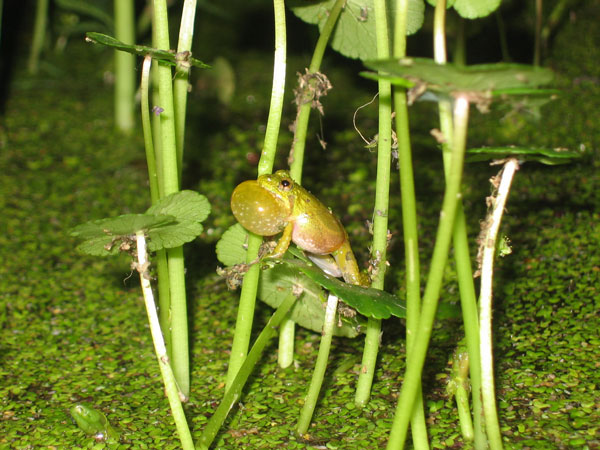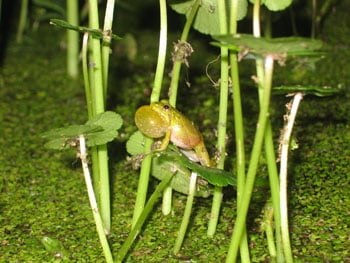Biologist speculates development and bullying by northern cricket frog, but not the Chytrid fungus or invasive predators.
Climate change, development, loss of wetland habitat and "bullying" from the northern cricket frog (Acris crepitans) may be the reasons that the southern cricket frog (Acris gryllus) in South Carolina is in decline, according to Jonathan Perry Micancin, a visiting lecturer at the University of North Carolina at Chapel Hill and a Ph.D. graduate of the school's biology department. Micancin studied the northern and southern cricket frog for his dissertation and is conducting ongoing research on both species.

Jonathan Perry Micancin
Southern Cricket Frog
Micancin examined specimen data collected from the 1960s and compared that data to current field data he and his students collected over several summers and found that while the northern cricket frog can be found in its usual habitats from the Piedmont region west to the Appalachian foothills, the southern cricket frog has disappeared from the Upper Coastal Plain that separates the Chowan and Cape Fear Rivers. The southern cricket frog is found from the Piedmont to the coast. Both species overlap in the Upper Coastal Plain.
Want to Learn More?
State of Illinois to Hold Frog and Toad Survey Orientation on January 28
N.C. Wildlife Resources Commission Releases Booklet on Building a Backyard to Attract Herps
Amphibian Populations in the United States Declining at Fast Rates
"It’s a steady flow of bad news for amphibians,” Micancin said. "We don’t know yet why this is happening, but we can expect that it does not bode well for amphibians and other animals that share their habitats, including humans,” he said.
Micancin, whose family has resided in northeastern North Carolina for many generations, speculates that because of its slightly smaller size, the southern cricket frog may not be able to compete with the larger northern cricket frog. He also points to the state's growth in the last few decades with more roads, parking lots, residential developments, bigger farms and the clear cutting of pine forests as potential reasons for the frog's dwindling populations. Micancin told ReptileChannel that he does not suspect the chytrid fungus or invasive predators as contributing to the decline of the southern cricket frog.
Hear the call of the southern cricket frog in the video below:
"There are several reasons why we do not suspect chytrid or invasive species as causes of decline of A. gryllus (southern cricket frog)," Micancin said. "Acris crepitans, a sympatric species, appears to be doing fine in many of the same wetlands where A. gryllus has vanished since the early 1960's. They are so similar physically and ecologically that it seems unlikely that chytrid or an invasive predator would affect one and not the other. Also, the decline of A. gryllus is at the northern limit of its range (North Carolina and Virginia resembles the decline of other cricket frogs at their northern range limits, A. crepitans in the Northeast and A. crepitans/A. blanchardi in the Midwest). This suggests that the causes of the decline of A. gryllus are similar to the causes of decline of other Acris species. The difference in North Carolina and Virginia, Micancin said, is that many places still have cricket frogs, just not the southern cricket frog.


